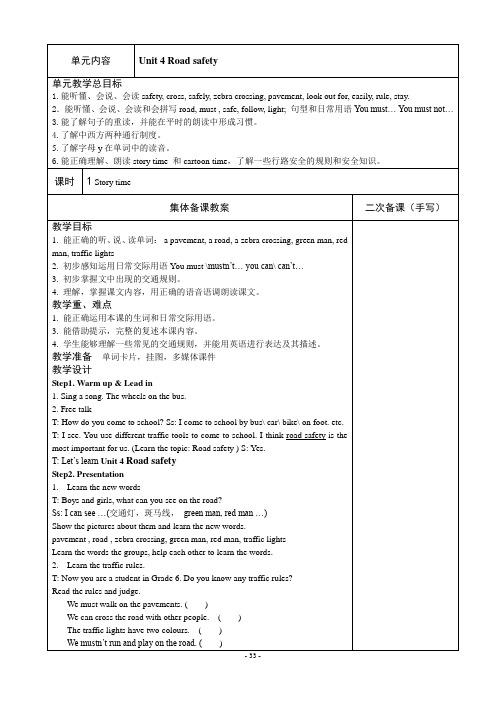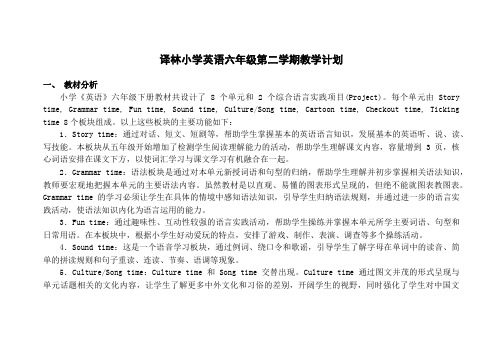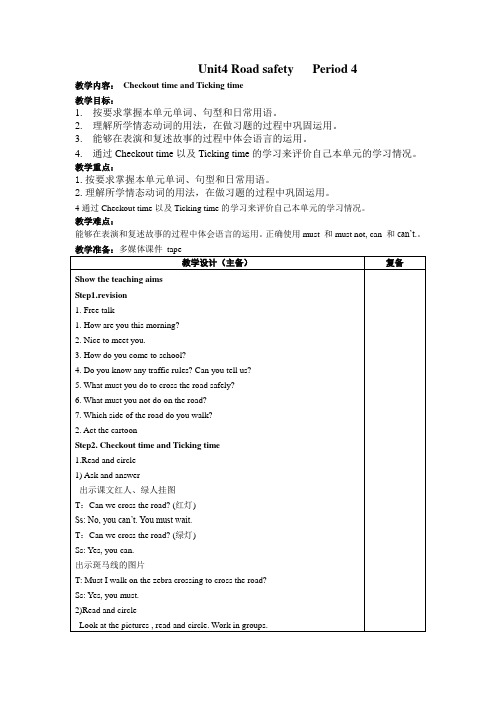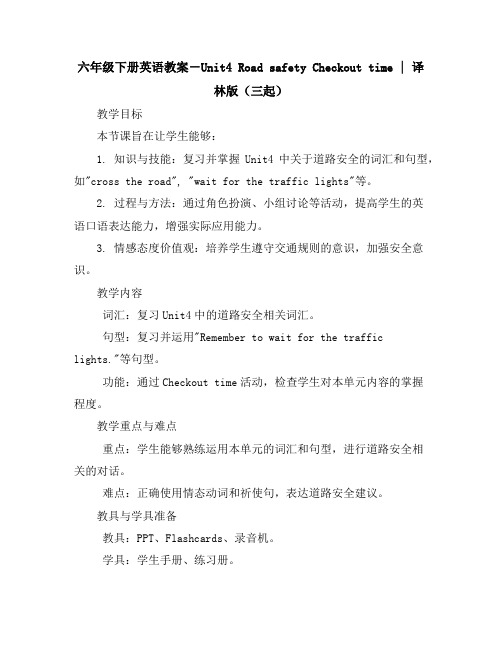六年级英语译林版下册_Unit4_Checkout_time_Ticking_time教学设计
(完整版)译林英语六年级下册Unit4教案

Do you know “must”?
Ss: Yes.
T: Mustn’t means you shouldn’t do the things. mustn’t= must not.
E.Before crossing the road, you must first look left, then right and then left again.
2) Listen and repeat
Read in groups, help each other to read the text.
Step2. Presentation
1.Learn the new words
T: Boys and girls, what can you see on the road?
Ss: I can see …(交通灯,斑马线,green man, red man …)
Show the pictures about them and learn the new words.
pavement , road , zebra crossing, green man, red man, traffic lights
Learn the words the groups, help each other to learn the words.
2.Learn the traffic rules.
can:能,可以。Can’t:不能,不可以,是否定形式。后面都接V原形.
译林英语六年级下册 Unit4 Road safety 第四课时Checkout time& Ticking time公开课教学设计

译林英语六年级下册Unit4 Road safety Teaching contents教学内容:Checkout time& Ticking timeTeaching aims and learning objectives教学目标:1. Review Story time, Ss can talk about what they must and must notdo on the road.2. Ss can use ‘must’ and ‘must not’ correctly.3. Ss can know that they need to read some words in a sentencemore loudly.4. Ss can finish the exercise in Checkout time, and they can evaluatehow well they’ve learnt this unit.5. Ss can know that there are rules everywhere and everyone mustfollow the rules.Focus of the lesson and predicted area of difficulty教学重难点:1. Ss can talk about what they must and must not do on the road.2. Ss can use ‘must’ and ‘must not’ correctly.3. Ss can know that they need to read some words in a sentencemore loudly.Preparation教学准备:PPTTeaching procedures教学过程:Step1 Greetings and lead-in1. Review the topic of this unit: Road safetyT: What’s the topic of this unit?2. Show the three learning aims of this class, ask Ss to read them.Step2 Aim1T: Let’s try to achieve Aim1.1. Sing a song ‘Safety on the road’T: What we must and must not do on the road is road safety. Let’s enjoya song about road safety. Try to follow it.2. Brainstorming3. Play a gameTips: T asks Ss some Qs, if the answer is yes, Ss stand up and answer loudly; if the answer is no, Ss sit down and say in a whisper; Ss should say the whole sentences.4. Ticking timeAsk Ss to look at Aim1, and tick out the stars he/ she can get.Ask some Ss to share with others.Step3 Aim2&3T: It’s your turn to finish the exercise in Checkout time.1. Read and circlea. Ask Ss to read and circle by themselves on P44 in 90s.b. Check the answers in pairs.c. Help Ss correct the mistakes and make them understand them.2. Read and acta. Ask Ss to read after the tape. Pay attention to the words we need to read more loudly.b. Ask Ss to act in pairs. Pay attention to the actions and facial expressions.c. Show in the front.3. BrainstormingT: Just now we talked about the rules on the road and rules at home. And there are rules everywhere. What other places we must follow the rules do you know?4. Practicea. Talk about the rules in the library. Ask Ss to read.b. Talk about the rules at the zoo. Ask Ss to fill in the blanks.c. Talk about the rules in the museum. Ask Ss to make up a dialogue in pairs.5. Think and writeShow a poster about classroom rules. Ask Ss to complete it w ith ‘must’ and ‘must not’.a. Ss fill in the blanks by themselves.b. Check the answers.c. Show the accent marks, ask Ss to read in groups. Pay attention to the words we need to read more loudly. Ss can read together or read one by one.d. Ask some Ss to read in the front.6. Ticking timeShow Aim2&3, ask Ss to tick out the stars they get, and share with others.Step4 Enjoy a video1. Let Ss enjoy a video about the rules.2. Summary: We must follow the rules. Rules make the world more beautiful.Step5 Homework1. Read and recite Checkout time;2. Make a poster about the rules in the library/ museum/ supermarkets/…Blackboard design板书设计:Unit4 Road safetyYou must…You mustn’t…We must follow the rules.。
译林版 小学六年级下册 Unit4 第四课时 ppt课件

listen to music drive after or play drinking alcohol
Share some photos
It meIanaslso ytoouokcasno…m你e可p以hoto/ysoaubsohuotultdr…af你fi应c该sig建n议s或. 许可,语气柔和
助动词
But don’t run.
Share feelings
Share a diary.
July, July. I’d like to share my diary.
Jane
It’s about what made me happy
when being a road safety guard.
我来分享日记啦。
You mustn’t… 你禁止 你会说什么呢?
强制,语气强烈
make a call when driving
read when
walking
listen to music or play
drive after
drinking alcohol
Share some photos
建议,语气柔和
Don’t… 不要 You can’t… 你不可以 You shouldn’t… 你不应该
提醒重要信息。
Homework
1. Read Sound time and Checkout time five times. 2. Choose one public place, and get ready for making posters.
You can collect materials for the content.
It means
(完整版)译林英语六年级下册Unit4教案

4.理解,掌握课文内容,用正确的语音语调朗读课文。
教学重、难点
1.能正确运用本课的生词和日常交际用语。
3.能借助提示,完整的复述本课内容。
4.学生能够理解一些常见的交通规则,并能用英语进行表达及其描述。
教学准备单词卡片,挂图,多媒体课件
教学设计
Step1. Warm up & Lead in
C.You can cross the road with other people. Because the driver can see you easily.
D.Then, you must look at the traffic lights and wait for the green man.
1.Finish P38 Think and plete the notes below.
2.把教室的布置成街道,让学生边走边说出安全过马路的步骤和注意事项。
Show in groups. Then show in front of the class.
Step5Homework
1. Listen to the tape, read story time fluently..
c. Discuss in groups and make sentences..
2.Choose the words to complete the sentences.
“must、mustn’t、can、can’t”.
Wetalk loudly in the library.
Youeat too much sweet food.
What must you not do on the road ?
译林小学英语六年级下册教学计划

译林小学英语六年级第二学期教学计划一、教材分析小学《英语》六年级下册教材共设计了 8个单元和 2个综合语言实践项目(Project)。
每个单元由 Story time, Grammar time, Fun time, Sound time, Culture/Song time, Cartoon time, Checkout time, Ticking time 8个板块组成。
以上这些板块的主要功能如下:1.Story time:通过对话、短文、短剧等,帮助学生掌握基本的英语语言知识,发展基本的英语听、说、读、写技能。
本板块从五年级开始增加了检测学生阅读理解能力的活动,帮助学生理解课文内容,容量增到 3 页,核心词语安排在课文下方,以使词汇学习与课文学习有机融合在一起。
2.Grammar time:语法板块是通过对本单元新授词语和句型的归纳,帮助学生理解并初步掌握相关语法知识,教师要宏观地把握本单元的主要语法内容。
虽然教材是以直观、易懂的图表形式呈现的,但绝不能就图表教图表。
Grammar time 的学习必须让学生在具体的情境中感知语法知识,引导学生归纳语法规则,并通过进一步的语言实践活动,使语法知识内化为语言运用的能力。
3.Fun time:通过趣味性、互动性较强的语言实践活动,帮助学生操练并掌握本单元所学主要词语、句型和日常用语。
在本板块中,根据小学生好动爱玩的特点,安排了游戏、制作、表演、调查等多个操练活动。
4.Sound time:这是一个语音学习板块,通过例词、绕口令和歌谣,引导学生了解字母在单词中的读音、简单的拼读规则和句子重读、连读、节奏、语调等现象。
5.Culture/Song time:Culture time 和 Song time 交替出现。
Culture time 通过图文并茂的形式呈现与单元话题相关的文化内容,让学生了解更多中外文化和习俗的差别,开阔学生的视野,同时强化了学生对中国文化的认同感。
译林版 六下Unit4Road safety五课时 (4)

Unit4 Road safety Period 4
教学内容:Checkout time and Ticking time
教学目标:
1.按要求掌握本单元单词、句型和日常用语。
2.理解所学情态动词的用法,在做习题的过程中巩固运用。
3.能够在表演和复述故事的过程中体会语言的运用。
4.通过Checkout time以及Ticking time的学习来评价自己本单元的学习情况。
教学重点:
1.按要求掌握本单元单词、句型和日常用语。
2.理解所学情态动词的用法,在做习题的过程中巩固运用。
4通过Checkout time以及Ticking time的学习来评价自己本单元的学习情况。
教学难点:
能够在表演和复述故事的过程中体会语言的运用。
正确使用must 和must not, can 和can’t.。
小学英语译林版六年级下册Unit...

小学英语译林版六年级下册Unit...小学英语译林版六年级下册Unit4 Road safety《Checkout time & Ticking time》优质课公开课教案教师资格证面试试讲教案1教学目标1.准确运用句型We must/mustn’t 谈论交通安全;2.能结合语境,准确运用must, mustn’t, can, can’t.;3.准确运用含有must, mustn’t 的句型,谈论班级规则等,并尝试写一写,制作成海报。
4.进一步强化规则意识,做一个懂规则,守规则的人。
2学情分析四年级学生已经有了一年多的英语基础,所以在教学上比三年级要容易些,课堂管理比较有序。
大部分学生课堂表现都很活跃、很积极。
课堂中会采用各种形式的游戏,及教学辅助用品一方面用来调动学生的积极性,另一方面用来帮助学生理解、记忆所学内容。
3重点难点1.准确运用含有must, mustn’t 的句型,谈论班级规则等,并尝试写一写,制作成海报;2.能结合语境,准确运用must, mustn’t, can, can’t。
3.含有must, mustn’t 的句型的准确表达及正确运用。
4教学过程活动1【导入】Step 1 Warm up1.ReviewStudents think some words or phrases about rules as more as possible.2. Ask and answerTalk about the rules on the road and at home. Boys use the sentence: We mus t….. Girls use the sentence: We mustn’t…3.Play a game“I’m a policeman”.(Fun time)T:The policeman knows a lot about the rules on the road. Let’s play a game abo ut the rules on the road.游戏规则:(Explain the game)将学生分成五人一小组,仿照Fun time范例,开展“红绿灯”游戏问答,一人演交警,提出问题,指定某人回答,其他人要给予反馈。
译林版六年级英语下册第一单元时Checkout<time&ticking<t

译林版六年级英语下册第一单元时Checkout<time&ticking教案【教学目标】1.理解数字表达时间并能够正确发音。
2.熟练掌握数词的读音与写法。
3.能够运用所学知识,用英语描述时间和日常生活的相关事宜。
4.培养学生的合作和交流意识,提高学生的口语表达和听力能力。
【教学重点】1.数字表达时间和日常生活的相关事宜。
2.数字的发音以及数词的读音与写法。
【教学难点】1.能聆听英语口语并准确地表达并与同伴交流。
2.理解不同的时间格式及与日常生活的联系。
【教学准备】1.PowerPoint展示、课堂活动2.学生课本及练习册【课程内容】步骤一、导入1.打印数字表格并展示在教室的墙壁上,要求每个学生背下表格上的数字。
2.利用与本单元相关的数字,问学生时间是什么,引导学生理解时钟的时间。
3.通过精彩的视频,以及实际情景演示来形象化地阐述数字时间的概念。
题型逐步升级,从简单的数字到完整的时间表达。
步骤二、学习新知1.开始教授新的单词,如数字“10”、“30”等等。
2.通过图片和音频的展示,要求每一位同学记忆和了解新单词的英文意思。
学生们必须通过展示新单词口头表达的方式来回应老师的提问。
3.解释新词的英文发音和汉语意思;要求每个学生在课堂上背诵,熟悉掌握每个单词的意思、发音和拼写。
4.教师让学生大声朗读单词,并检查每个学生是否听懂了。
步骤三、巩固练习1.在课堂上进行练习。
使用单词卡片,要求学生熟悉每个数字的发音和正确书写。
2.利用图示或实物,让学生以非书面化的形式展示其对所学单词的使用方式和理解。
3.教师讨论学生的成果,并纠正与引导他们,在学习中不断加深理解。
4.教师提供对于书写数字的帮助和指导,以便每位学生更好地掌握数字1至100的写法和发音。
步骤四、拓展扩展1.以本单元所学为基础,综合使用相似或相关的数字进行对话,提高学生的语言表达能力。
2.教师可以提供语言活动,如问题环节和研究性任务,以促进学生的个人思考和交流。
六年级英语下册Unit4Grammar time, Checkout time

I can use “must” and “must not”.
I know that I need to read some words in a
sentence more loudly.
Summary
t
5. I _c_a__n_’ _ go shopping with you because I am butsy now.
6. You __c_a_n___cross the road with other people.
Then the driver ___c_a_n__ see you easily.
Grammar time
Read the sentences in the form: 理解must, mustn’t, can和
can’t/cannot 的含义以及基本用法。
How What
can must
情态动词+动词原形
cross the road safely
you
?
not do on the road
You
must
tone. “Can”
go
mYyooeuuanwcsailnl“bpgeoerlnamoteiws! ,soiorn”.
now, or you will be late!
You should go now, or you will be late!
must/mustn’t
must意为“必须”,语气最强,表示命令或权 威;其否定形式是mustn’t,意为“禁止”。
7. I have a headache. What _s_h__o_u_l_ I do? 8. —What__m__u_s__ you not dod in the library?
六年级下册英语教案-Unit4RoadsafetyCheckouttime|译林版(三起)

六年级下册英语教案-Unit4 Road safety Checkout time | 译林版(三起)教学目标本节课旨在让学生能够:1. 知识与技能:复习并掌握Unit4中关于道路安全的词汇和句型,如"cross the road", "wait for the traffic lights"等。
2. 过程与方法:通过角色扮演、小组讨论等活动,提高学生的英语口语表达能力,增强实际应用能力。
3. 情感态度价值观:培养学生遵守交通规则的意识,加强安全意识。
教学内容词汇:复习Unit4中的道路安全相关词汇。
句型:复习并运用"Remember to wait for the traffic lights."等句型。
功能:通过Checkout time活动,检查学生对本单元内容的掌握程度。
教学重点与难点重点:学生能够熟练运用本单元的词汇和句型,进行道路安全相关的对话。
难点:正确使用情态动词和祈使句,表达道路安全建议。
教具与学具准备教具:PPT、Flashcards、录音机。
学具:学生手册、练习册。
教学过程1. 复习导入:通过PPT展示Unit4中的关键词汇和句型,帮助学生回忆和复习。
2. 小组活动:学生分组,根据Flashcards上的提示,进行道路安全情景模拟。
3. 角色扮演:学生扮演警察和行人,模拟道路安全场景,练习使用本单元的句型。
4. 课堂展示:每组选取代表进行课堂展示,其他学生进行评价。
板书设计关键词汇:cross the road, traffic lights, wait, remember 句型:Remember to wait for the traffic lights. / Don't cross the road now.作业设计书面作业:完成练习册上的相关练习。
口头作业:与家长进行道路安全主题的英语对话。
课后反思学生对本单元内容的掌握情况良好,但在实际应用中仍需加强对祈使句的运用。
Unit4(教学设计)Checkout time 六年级英语下册(译林版三起)

3.Choose a place and make some rules......
通过填空的方式练习词汇。然后根据练习题等来巩固练习本节课词汇和句型。
Part 4:
Summary。总结本节课学习内容。
Step V:Summary
1.T:Now let’s summarize that what have we learned?
教学
工具
PPT,课文视频,音频
教学
方法
情境教学法,任务教学法,演示法
教学过程
学习任务
教学活动
设计意图
Part 1:
Warm up。热身。
Step I: Warm up
1.Watch a short video
Q: What are they talking about?
Q: What are the four steps?
Part 2:
Let’s learn.学习本节课重点单词与句型。
Step II: Let’s learn:
1.Choose and read with stress
2. Discuss
Discuss the differences between must and can.
3.Think and write
When we're at home, we should follow some rules. When we go to school, in order to keep safe on
the road, we should follow the traffic rules. When we are at school, we shouldalso follow the classroom rules, right? So let's find out our class rules. First, discuss in groups. Then, write down the rules on the paper.
译林版六年级英语下册第四单元Checkout,Ticking time课件(南京集体备课)

6
7.We must listen to our teachers in class.
Think and write
Classroom rules(用must和mustn't填空)
1 You__m_u_s_tn_’t__ run in the classroom. 2 You __m_u_s_t __ keep your desk clean and tidy. 3 You __m_u_st_n’_t_ eat or drink. 4.You __m_u_s_tn_’t__ play ball games. 5.You __m_u_s_tn_’t__ talk loudly. 6. You __m__us_t___ keep the classroom clean. 7. You ___m_u_st___ listen to your teachers in class.
d 8. We mustn’t draw on our desks. b
4. We mustn’t eat or drink.
b 9. We mustn’t run fast.
c
5. We must wait for the green man. c 10. We mustn’t pick the flowers. d
Let’s talk
Tips: When we give advice to others, we should pay attention to our tones.
当我们给他人建议时,应注意语音语调。
Rules in different places: 选择一个地点,谈论规则,完成海报初稿。
(m讨u论st一表下示mmu说usts话ta和n人dc“caann不.的许区”别和。)
英语六年级下册译林版第4单元

英语六年级下册译林版第4单元全文共四篇示例,供读者参考第一篇示例:英语六年级下册译林版第4单元是围绕“课外活动”这一主题展开的。
在这一单元中,学生将学习有关不同课外活动的词汇、动词时态以及如何描述自己的爱好。
在这一单元中,学生将学习一些有关课外活动的词汇,比如music, sports, drawing, dancing等。
通过学习这些词汇,学生可以更好地了解不同种类的课外活动,并且能够用英语正确描述这些活动。
学生可以通过学习这些词汇,说出自己喜欢的课外活动是什么,并且能够表达自己的兴趣爱好。
在这一单元中,学生还将学习不同动词时态的用法,比如一般现在时、一般过去时等。
通过学习这些动词时态,学生可以更好地描述过去和现在发生的事情。
学生可以用一般过去时叙述自己昨天做了什么课外活动,或者用一般现在时描述自己每天都会做的活动。
在这一单元中,学生还将学习如何描述自己的爱好和课外活动。
通过这一部分的学习,学生将会学会如何用正确的句子结构来表达自己的爱好。
学生可以说“I like playing basketball”来表达自己喜欢打篮球,或者说“She enjoys dancing”来描述别人喜欢跳舞。
英语六年级下册译林版第4单元是一个关于课外活动的单元,通过学习这一单元,学生将能够更好地了解不同种类的课外活动,掌握不同动词时态的用法,并且可以用英语描述自己的爱好和课外活动。
这将有助于提高学生的英语口语表达能力,同时也增强他们对英语课外活动的兴趣和认识。
希望学生们在学习这一单元的过程中能够收获满满的成长和快乐!第二篇示例:英语六年级下册译林版第4单元主题为“How do you get to school?”本单元主要介绍了不同的交通工具和描述如何到达学校的方式。
通过学习本单元,学生将能学会用英语描述自己每天上学的方式,并且能够与他人分享自己的交通方式。
本单元还介绍了如何描述到达学校的方式。
学生可以学会用英语描述从家里到学校的路程。
Unit4 Road safety(Checkout time)(课件)译林版(三起)英语六年级下册

Ticking time.
I know what I must and must not do on the road.
Share rules in different places.
小组合作,在1分钟内准确说出指定地点的规则,越多越好!
chcionlaibsenpmrtaietareaynl
clapssarrokom
没有规矩不成方圆
Homework.
1. Finish the exercises. 完成伴你学 2. Review Story time and Cartoon time.
Must do
1. Make a mind map of Unit4 Grammer.梳理Unit重点语法知识,
制作知识点导图。
Watch and choose. Choose the rules of the classroom.
Walk in school. Don’t run or skip. 在学校里走。不要跑跳。 Keep your hands and feet to yourself. 把你的手和脚放在自己的区域。 Run around and play together.
Ticking time.
I can use “must” and “must not”.
Know more about road safety and traffic rules
Get to know.
Rules can make us safe and happy.
Summary I know
2. Group work:小组合作,选择一个地点,完成规则制定。
hospital
cinema
canteen
译林英语六下U4 Checkout time and Ticking time课件

You mustn’t talk loudly in the libra. ry
You must follow the rules in the library.
Follow the rules to make our life better.
遵守规则,让我们的生活更美好。
知道在马路上必须做和禁止做的事情。 能正确使用情态动词must和must not。
1. Talk about Library rules with your parents.(和你的父母说一说图书馆规则。) 2. Make a mind map of Classroom rules.(制作一张教室规则的思维导图。)
must 和can都是情态动词,肯定形式和否定形式 (mustn’t/can’t)后都加动词原形。
must 表示必须做某事,强调主观上的必须,有很强的 劝告语气。can表示有能力或有权利做某事。
Tips:我们在劝告别人的时候,要注意语音 语调以及你所强调的重点。你能准确地读 出下列句子中需要重读的单词吗?
’Stop! There’s a ’red man. We ’mustn’t walk now.
We must ’wait for the ’green man.
’There he is! ’Now we can walk,
But’ don’t run!
一般情况下,句子中的名词、动词、形容词和副词需要重读。
2. We must read quietly. 4. We must keep quiet. 6. We must wait for the green man.
You must
.
You must
.
You mustn’t
新译林版六年级下册Unit4教案

2)Line down the answers of these queations.
Questions:
①Where must we wait before we cross the road?
②What should we do when we wait?
板书
设计
Unit 4 Road Safety
(story time)
Rule1:We must look for a and look at the .
Rule 2:We can wait on the and look out for cars and bikes.
We can also cross the road with .
T: What can you see in the pictures?
Ss: Some boys are playing football by the road. A boy is skating\running on the road.
T: Is it sare are many cars and bikes on the road.
3.能用正确的语音语调朗读Story time。
4.能理解道路安全知识,尝试用英语说说道路交通规则。
5.能牢记过马路的交通规则,树立安全意识。
内容分析
重点
1.能理解道路安全知识,尝试用英语说说道路交通规则。
2.在Storytime的学习过程中掌握有关道路交通方面的新词road, light, zebra crossing, pavement, look out for, easily, rules, follow,must,safety,safely。
译林英语六下(三起点)U2 Sound time Checkout time 第4课时教学设计

Unit 2 Good habitsCheckout time&Ticking time单元Unit 2课时第4课时学习目标1. 能正确完成Checkout time 中的练习。
2. 能对照Ticking time 中的三个目标进行正确的评价。
3. 能熟练掌握一般现在时,并灵活运用副词。
4. 能分析和判断什么是好习惯、什么是坏习惯,灵活运用本单元的重点句型进行关于habits的话题讨论。
教学重难点1.能正确完成Checkout time中的练习。
2. 能熟练掌握一般现在时,并灵活运用副词。
3. 能灵活运用本单元的重点句型进行关于habits的话题讨论,帮助学生在今后学习和生活中形成好习惯、摈弃坏习惯。
学情分析通过几年的英语学习,六年级学生的英语语言素养已经达到了一定的水平,在情感态度、价值观方面已经初步形成了正确的、积极的、明确的是非观念。
对于哪些是好习惯,哪些是不好的习惯,他们已经具备了一定的判断能力。
对于为什么要形成好习惯及如何形成好习惯,还需深入引导。
教学中,借助图片、视频等引导学生复习。
能在朗读、交流、探究等学习活动过程中及过程后辨别好、坏习惯,提出合理的建议,让更多人形成好习惯。
教学工具PPT,课文视频,音频教学方法任务驱动法,合作探究法教学过程学习任务教学活动设计意图学习任务一:复习导入。
让学生看到出现的图片或句子,判断是好习惯还是坏习惯。
回忆王兵和刘涛的习惯。
1.Play a game.(say“Good” or “Bad”)2.Review and say.Review Wang Bing and Liu Tao’s habits.通过图片和句子,引导学生多联系自己的实际情况,分析和判断什么是好习惯和坏习惯。
温故知新,调动学生的学习兴趣。
自然的引出Checkouttime中苏海和苏阳的生活。
学习任务二:Checkout time要求学生听一段文字,然后选择正确的答案完成句子或回答问题。
六年级英语下册课件-Unit 4 Road safety(Checkout time-Ticking time)(3)-译林版

TTSThhhhiinoinnkwkkaaannndddmwswahrrkaiiterteee
This is our poster. You must/mustn't/...... know the rules. Follow the rules.
I know that I need to read some words in a sentence more loudly.
√
Think and write 1.完成课本44页填空 ! 2.核对答案并改正错误!
must not must
must not must not must not
must must
Ticking time
I know what I must and must not do on the road.
I can use “must” and “must not”.
√
I know that I need to read some words in a sentence more loudly.
Jack
Read and check
Read and check
Read and check
Read and act
Can I watch TV?
Tips:1.注意重读的单词哦; 2.表演时注意动作和语气哦
What can you do? I can run fast.
No, you can’t. It’s late. You must go to bed now.
- 1、下载文档前请自行甄别文档内容的完整性,平台不提供额外的编辑、内容补充、找答案等附加服务。
- 2、"仅部分预览"的文档,不可在线预览部分如存在完整性等问题,可反馈申请退款(可完整预览的文档不适用该条件!)。
- 3、如文档侵犯您的权益,请联系客服反馈,我们会尽快为您处理(人工客服工作时间:9:00-18:30)。
英语(六年级下册)Unit 4 Road safetyCheckout time & Ticking time苏州工业园区星港学校纪玮一、Teaching contents 教学内容Checkout time & Ticking time二、Teaching aims and learning objectives 教学目标1.准确运用句型We must/mustn’t 谈论交通安全。
2.能结合语境,准确运用must, mustn’t, can, can’t。
3.准确运用含有mus t, mustn’t的句型谈论班级规则等,并尝试制作成海报。
4.进一步强化规则意识,做一个懂规则、守规则的人。
三、Focus of the lesson and predicted area of difficulty 教学重点和难点教学重点:1. 准确运用含有must, mustn’t的句型谈论班级规则等,并尝试制作成海报。
2. 能结合语境,准确运用must, mustn’t, can, can’t。
教学难点:含有must, mustn’t 的句型的准确表达及正确运用。
四、Teaching procedures 教学过程Step 1 Lead-in1. Greetings: Date/Weather.2. Review Cartoon timeT: Yesterday Bobby and Tina went to see their aunt. They took a bus. But the bus stopped twice, why?3. PK time.T: Let’s talk about the rules on the road and at home. Bo ys use the sentence: We must…..Girls use the sentence: We mustn’t…【设计意图:由复习卡通来引出道路安全的对话主题,让学生进行比赛,快速地运用句型来操练,帮助学生复习巩固语法。
】Step 2 PresentationRead and underline.1. T: What rules do they need to observe? Please read and underline.2. Check the answers.Picture1:T: The first picture, which pair wants to try?S1: Can I watch TV?S2: No, you can’t. You must go to bed.T: Can you watch TV every day?S: No, we can’t. We can watch TV at weekends.(同法进行图2和图3)3. Discuss the differences between must and can.T: must 表示说话人“不许”和“禁止”某人做某事,有很强的劝告语气。
Can表示有能力或有权利做某事。
【设计意图:must和can在使用中有相同之处,例如后面都跟动词原形,但是在意思上还是有区别的,教师用简洁明了的句子帮助学生区分,避免混淆。
】Step 3 WritingT: When we’re at home, we should follow some rules. When we go to school, in order to keep safe on the road, we should follow the traffic rules. When we are at school, we should also follow the classroom rules, right?1. Match and say(1) T: What are they doing?S: They’re talking to each other.T: What do you want to say to them?S: You must keep quiet./ Y ou mustn’t talk to each other. / You must listen to the teacher.(2) T: How about other students? Which class rules are the students breaking? Write thenumbers in the circles in pairs.(3) Check and discuss2. Think and write(1) T: Liu Tao wants to make a poster about his classroom rules. Let’s help him.Please complete the poster with “must” and “must not”. (PPT呈现海报)(学生尝试写)(2) Check the answers.S1: You mustn’t run in the classroom.T: It’s easy to bump into someone (撞到别人).(同法检测答案,教师在学生回答的过程中,注意追问和拓展)3. Talk and write(1) T: I think classroom rules are important for us. So let’s make our class rules.First, discuss in groups. Then, write down the rules on the paper. (每位学生写出一条自己觉得最重要的班规)(2) Make a poster togetherT: Talk about the rules, choose some of them and stick on the poster.T: Show your paper and read it loudly, please.S1: We must/mustn’t…T: Is this a good rule?S1: Yes.T: Who has the same idea?…(让各组读一读自己的班规)(3) Take an oath: This is our classroom rules. I will abide by them.3. Talk about the rules in different places.T: We have rules on the road, in the classroom. Where else do we have rules?S: We have rules in the library/ in the park…(1) Read, think and match.T: Here are ten rules. Where do we have them? Please think and match in pairs. (PPT呈现配对题,教师引导学生用句子描述,如:We mustn’t walk on the grass in the park.) (2) Let’s talkT: When you are in public places, please follow the rules and be a polite student. If you observe some impolite behaviors, do you have the courage to warn them? How to warn them? What will you say?T: Remember! When we give advice to others, we should pay attention to our tones.(3) Make postersT: To make our life more beautiful, we need rules. For example, the park rules, the bank rules, the hospital rules, the library rules, family rules and so on. Choose one and make a poster in groups of four.【设计意图:语言的使用不仅仅在于简单地会说会表达,更应该给学生带来能力上的提高,因此教师设计了班规的制定这一活动,使每个学生都能积极思考和参与,锻炼了口语的同时,也潜移默化地对学生进行了文明礼仪的教育。
】五、Homework 家庭作业1. 通过调查、观察等方式,进一步完善相关场所的规则。
2. 依据Ticking time,自主复习相关知识点。
六、Teaching aids 教学准备教学准备:PPT课件、纸等说课本课设计以句型的复习巩固以及运用为主,引导学生准确运用句型We must/mustn’t 来谈论交通安全,通过句型的操练帮助学生区分must, mustn’t, can, can’t,并能结合语境,准确运用这些情态动词,最后让学生一起参与制定班规并制作成海报的活动,既做到了学以致用又强化了学生的规则意识,引导他们做一个懂规则、守规则的人。
特别分享:·关注学生对语言的运用;·关注学生的小组合作能力;·关注学生制作海报能力的培养;·培养学生做文明人,守规则、重约定。
